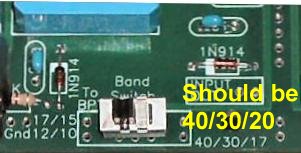

Bottom PlateThe following text describes how to put the receiver together as shown on the Home Page. If you have a problem when testing the boards, go to "LED Diagnosis/Troubleshooting" for help. ____Use a piece of PCB, aluminum plate, or steel plate to use as the bottom piece of the receiver. Dimensions are 8 1/2" by 8 1/2", the same size as the boards. (A drilled PCB plate will be included with the kit as supplies last.) |
|
Instructions if drilled bottom plate is not included with the kit. ____Using Board 2, since it has not been built, as a template, drill holes through the bottom plate at the four corners. (Holes have already been drilled in the PCB material with most kits.)With the 6-32 size hardware supplied with the kit the holes need to be enlarged with a 9/64" drill bit. The holes are originally drilled for 4-40 size hardware. |
Mounting Board 1A space of 2 1/2" is needed between the bottom plate and Board 1. This leaves enough room for the DDS VFO LED Display and Transmitter components. ____Spacers (that use 6-32 hardware) are supplied with the kit. Two male/female spacers 1 1/4" long are attached and mounted with the female end on the bottom plate and attached with 6-32 screws. The holes at these locations have been drilled with a 9/64" drill bit to accommodate the 6-32 hardward. All other mounting holes are 1/8" that accommodate 4-40 hardware.____The minimum mounting holes is 4, one on each corner. If you use additional mounting holes and you use 6-32 hardware, but sure to enlarge the holes with a 9/64" drill bit. A maximum of 12 places can be used to mount Board 1. Please Note: The mounting holes are 1/8" to accommodate 4-40 hardware. Some have been drilled to 9/64" to accommodate 6-32 hardware. Depending on the size that will be used, note the different size holes. ____Connectors for +12 Volts, Antenna, and Speaker.These connectors are not supplied with the kit. The prototypes used RCA connectors that were soldered to the board. Connectors can be mounted to the bottom board with right angle brackets or on an aluminum plate mounted vertically on the bottom board. The Speaker connection is on Board 2. The DDS VFO display can be mounted onto the bottom plate, as shown below, with small right angle brackets and screws/nuts. In the middle would be better. After I put the knob on the DDS VFO encoder, it blocked the LED display some. Mount at an upward angle so as to get a good viewing angle when using the transceiver. With the DDS VFO on Board 1 of the receiver, as shown below, tuning noise will be heard outside of the peaks of the bands. Band noise, up to 15 meters, will hide the tuning noise. On 12 and 10 meters, tuning noise and spurs will be heard at low levels, but signals can be heard clearly, if not directly on top of a loud spur. |


|
|
|
|
|
____Connect +12 Volts to the +12 Volt and Ground connections near the output of the VFO. ____Be careful with polarity reversal. The 10mfd tantalums may explode and some traces may be burned going to the 7805 and First Mixer. Use diode protection if a mistake might be made in connecting the board to 12 Volts. ____Use a 1 amp diode, 1N4001 or similar at the 12 volt main connection (band goes to 12 Volt connection) to prevent accidentally hooking up the receiver with reverse polarity. (This diode is not currently supplied with the kit.) The band of the diode is connected to the 12 Volt connection. Other end is connected to the power supply. DDS VFO/VFO Amps/Bandpass Filter____Turn Bandpass Switch to 40/30/20 side. A mistake was made in the text, it reads 40/30/17.  ____The LED at the 40/30/20 side of the filters should be on. ____Move the Bandpass switch to the 17/15/12/10 side, the LED at the 17/15/12/10 filter should turn on. If the 40/30/20 LED at the Bandpass Filters is bright/dim, shield any light (overhead shop light, etc.) that is hitting the Photodiodes. The 40/30/20 LED should go out. TroubleshootingBandpass Tuning Pot____Place a VOM in DC Volts position, and measure the voltage at the FILTER TUNE Bold circle (in the middle between the filters), and check its range while running the Filter Tune pot from end to end: +.12 to +11.7 Volts (within a volt).TroubleshootingFirst Mixer/Post-Mixer Amplifier____First Mixer: The LED on the right should be on. This LED shows the output of the DDS VFO and the proper functioning of the 2N5109 amplifier.To test this and show its function, turn the 500K trimmer at the 1st MOSFET amplifier counterclockwise and the LED should go out. Turn it back clockwise and stop at the point where the LED reaches maximum brightness. ____VFO Post-Mixer Amplifier: The LEDs of the two Post-Mixer Amplifiers should be on. The reason for the different intensites of the LEDs is that they were different colors. They have a forward voltage drop of 1.7 to 2 Volts. Note: Do not put Super Brights in the Mixer or Post-Mixer amplifiers that have a 3.5 to 4 forward voltage drop. They will reduce gain considerably.  TroubleshootingCrystal Filters |

|
If you have already built Board 2, then go to Mounting/Testing Board 2. |
Send E-Mail || Amateur Radio Receivers || Back to Back to Instructions for the SuperLuminescent Receiver

